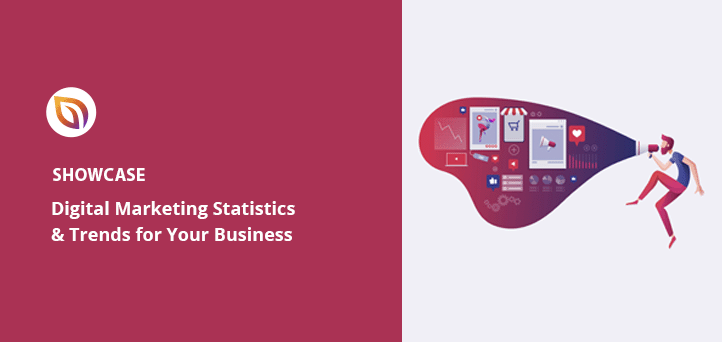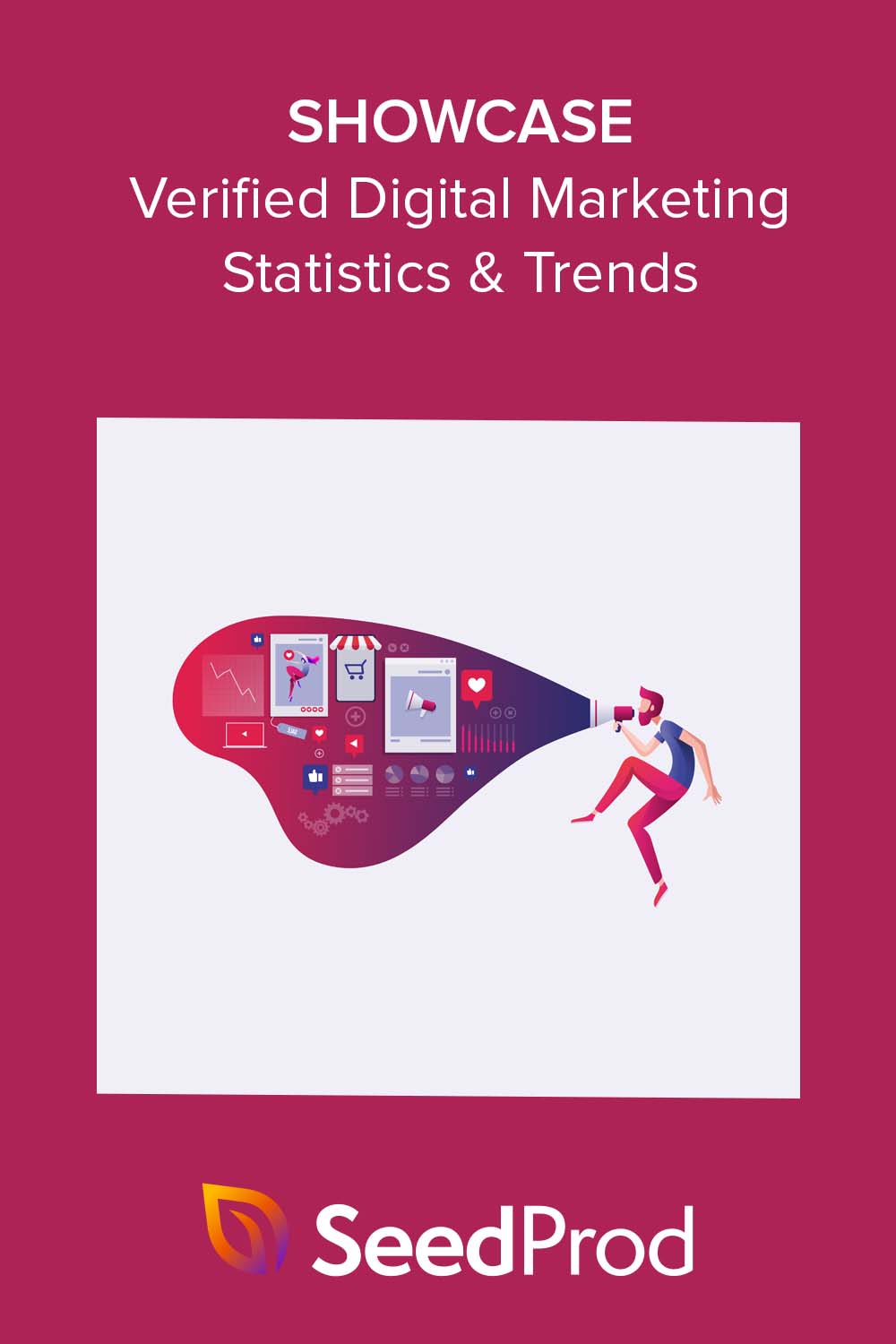Are you looking for the latest digital marketing statistics and trends?
Digital marketing is transforming the way businesses promote their products and services. It allows companies to reach a larger audience and engage with customers like never before. As technology advances, digital marketing is evolving, providing businesses with even more advanced tools and strategies to boost brand awareness and drive growth.
In this article, we’ll explore the latest digital marketing statistics to reveal the most effective tactics and trends business owners use to stay ahead of the competition. These statistics cover everything from social media marketing to email campaigns and search engine optimization (SEO), providing valuable insights into the current state of the digital marketing industry.
By understanding these trends and tactics, you can make informed decisions about your online marketing strategies. This will help you to stay relevant and competitive in the digital marketplace.
What Is Digital Marketing?
Digital marketing promotes products or services through various digital channels, including search engines, social media platforms, email, websites, and mobile apps. The goal is to reach a targeted audience and convert them into customers or clients.
Some of the digital marketing techniques you can use are as follows:
- Search engine optimization (SEO)
- Digital advertising
- Content marketing
- Social media marketing
- Social media advertising
- Email marketing
- And more.
What Are The Benefits of Digital Marketing?
Digital marketing is crucial for small businesses that want to connect with their customers, build brand awareness, and drive sales through online marketing efforts. As more consumers turn to digital channels for research and purchasing decisions, digital marketing has become essential to modern marketing strategies.
Moreover, a digital marketing strategy can offer several advantages for businesses, including:
- Increased visibility: Digital marketing techniques like search engine optimization (SEO) and pay-per-click (PPC) advertising help businesses reach a larger audience.
- Improved targeting: With digital marketing, businesses can target specific groups of customers by demographics, interests, and online behavior. This results in more personalized and relevant marketing messages.
- Cost-effectiveness: Compared to traditional marketing methods, it’s more cost-effective, making it a viable option for businesses on a budget.
- Better engagement: Digital marketing enables businesses to engage with customers in real-time through social media and chatbots, providing a more personalized experience.
- Measurable results: Digital marketing lets businesses track their marketing efforts and measure the results of their campaigns, making it easier to optimize their marketing strategies for the best return on investment (ROI).
- Flexibility: Digital marketing allows businesses to adapt their marketing strategies quickly and easily to changing marketing trends and consumer behavior.
By using digital marketing techniques, you can reach a wider audience, generate more leads, and grow your business online.
Ultimate List of Verified Digital Marketing Statistics
With the above in mind, let’s dive in and look at the most recent digital marketing stats for the different marketing channels online.
We’ll kick things off with email.
Email Marketing Statistics

Email marketing is a technique you can use to promote products or services, build brand awareness, and establish relationships with customers or clients. It involves sending messages to your target audience to encourage them to take a specific action, such as purchasing or signing up for a newsletter.
Check out the email marketing stats below for more information:
- There are 347.3 billion emails sent and received every day globally.
- 99% of email users check their inbox daily, and some check up to 20 times per day.
- 61% of consumers prefer email contact from brands.
- 49% of consumers want to receive promotional emails from their favorite brands weekly.
- 41% of email views are on mobile devices, while desktops make up 39%.
- The average email click-through rate (CTR) is 2.13%.
- Email marketing generates a $44 return for every $1 spent, resulting in an ROI of 4400%.
- 77% of the ROI comes from segmented, targeted, and triggered email campaigns.
- Email automation is used for triggered, drip, and segmentation campaigns.
- Testing emails results in a 28% higher ROI, with 47% of marketers testing subject lines.
- 47% of emails are opened or discarded based on the subject line alone.
- Personalized subject lines increase the email open rate by 22%.
- Subject lines with urgency and exclusivity result in a 22% higher open rate.
- Popups on a website can increase the email list by 1.375%.
- 15.8% of emails are missing or caught by spam filters.
The findings above demonstrate the value of email marketing as a powerful tool for engaging with your audience and driving results.
Social Media Marketing Statistics

Like email, social media marketing involves using social networks to promote your business with marketing campaigns. Those campaigns can take many forms, including organic social media posts, paid social media advertising, influencer marketing, social media contests, and more.
You can find the latest social media stats below:
- On average, most social media users have accounts on over 8 social media platforms.
- Typically internet users spend an average of 2 hours and 29 minutes on social media daily.
- 43% of people use social media to make purchase decisions.
- Facebook has 2.93 billion monthly active users, making it the most popular social platform.
- YouTube has 2.6 billion monthly active users, followed by Instagram with 2 billion, TikTok with 1 billion, Pinterest with 450 million, and Twitter with 330 million.
- LinkedIn is used by over 90% of B2B marketers for organic social marketing.
- Around 98.3% of Facebook users access the app from mobile phones.
- Marketers typically post 4 to 6 times weekly on most social media platforms.
- 84% of those marketers claim to target Millennials.
- 44% of Millennials use social media daily.
- Creating engaging content is the biggest challenge for 27% of social media marketers.
- 82% of marketers say they repurpose content across channels.
- According to 80% of survey respondents, funny content is the most effective.
- 68% of those marketers’ companies admit to working with influencers on social media.
- 64% also invest in building social media communities.
As social media platforms have billions of users, it’s common practice for businesses to add social media to their marketing plans. However, the main obstacle is producing content that captivates internet users.
Content that focuses only on promotion won’t generate the desired engagement. Therefore, marketers use tactics like repurposing blog posts, sharing memes, and working with influencers.
Content Marketing Statistics

Content marketing aims to share helpful information that appeals to your target audience and drives engagement with your product or service.
Below are some recent statistics for content marketing you’ll find helpful:
- 82% of companies report using content marketing.
- 48% of companies with a content marketing strategy use blogging.
- The most popular blog content formats are how-to articles (77%), followed by news and trends (49%), and guides and eBooks (47%).
- B2B blogs with educational content get 52% more organic traffic than B2B blogs with company-focused content.
- The leading content marketing types B2C marketers use are blog posts/short articles (83%), email newsletters (74%), and pre-produced videos (62%).
- For B2B marketers, webinars, online courses, and virtual events were the content types that produced the best content marketing results in previous years.
- 80% of marketers who produce audio content and podcasts plan to invest similar amounts or more in the future.
- Only 16% of marketers say they invest in audio chat rooms like Twitter Spaces and Clubhouse.
- 38% of marketers plan to include infographics in their content creation for the first time.
- 60% of marketers report that content marketing generates demand/leads.
- 70% of marketers say that content marketing helps to educate the audience.
- 60% of marketers also say it helps build loyalty with existing clients/customers.
- 76% of content marketers use organic traffic as a critical metric for measuring content success.
- Only 22% of content marketers use backlinks.
Blogging has long been a popular content marketing strategy, with how-to articles being the most favored format. Educational content in blogs can generate 52% more organic traffic than company-focused content. This highlights the importance of creating valuable content that addresses the needs of your audience rather than just promoting your brand.
In response to the pandemic, marketers have embraced virtual events such as webinars and online courses as an effective way to attract and engage their target audience without in-person events.
Search Engine Optimization Statistics

Search engine optimization involves improving your online content so users can find it more easily in search engines. As a result, you can increase organic traffic to your website, boosting leads and sales.
Here are some of the latest eye-opening SEO statistics:
- Google has 83.84% of the search engine market share.
- Over 105,191 searches per second are made on Google.
- 53% of shoppers research using a search engine before purchasing.
- 27% of people use voice search on mobile.
- 50% of search queries are at least 4 words long.
- About 8% of search queries are questions.
- The first 5 results displayed in search engines receive 67% of clicks.
- The #1 result in Google gets about 32% of all clicks.
- 75% of users never scroll further than the first page of the SERP.
- Only 3.4% of clicks on Google search results go to AdWords or paid search ads.
- 90% of web pages get zero organic traffic from Google.
- Google uses over 200 factors to rank websites, including keywords, content length, page speed, mobile usability, and more.
- Organic search results on page 1 of Google contain an average of 1,447 words.
- 71% of marketers claim that using strategic keywords was their top strategy for SEO.
- Over 50% of respondents measure the success of their SEO strategies based on keyword rankings and organic traffic.
- 49% of marketers report that organic search has the best ROI of any marketing channel.
After reading these statistics, it’s easy to see why search engine optimization is crucial for business.
With effective WordPress SEO, you can attract more visitors to your website via search results. Additionally, nearly half of the marketers admit that organic search has the best return on investment.
That said, it’s important to remember that most web pages don’t get any traffic from Google, which could be down to poor optimization efforts.
Video Marketing Statistics

Video marketing uses video to promote your brand, products, or services. By creating and sharing videos that provide value and capture attention, you can engage viewers and ultimately persuade them to take action.
With that in mind, here are some recent video marketing statistics to consider:
- On average, viewers spend 100 minutes per day watching video content.
- 86% of businesses use video as a marketing tool.
- 34.4% of marketers create new videos monthly, while 33% create them weekly.
- 74% of videos are explainer videos, making them the most common.
- Other popular video types are social media, presentations, testimonials, product demos, ads, and sales videos.
- 96% of people have watched explainer videos to learn about products or services.
- Videos under 1 minute long get the highest average engagement rate at 50%.
- 87% of marketers say video has helped them increase traffic.
- 82% also say video has helped improve dwell time.
- 94% of marketers admit that video has helped them grow their audience’s product understanding.
- 86% of marketers say video has helped them with lead generation.
- 81% of marketers say video has directly helped them increase sales.
- 49% of marketers attribute video to assisting them in reducing support calls.
Most marketers believe incorporating video into your business’s marketing strategy can increase traffic, leads, and sales. More importantly, adding video content to your strategy is easier than ever since anyone with a smartphone and access to the internet can produce them.
Lead Generation Statistics

Lead generation is about cultivating potential customers interest in your products or services and guiding them through your sales funnel until they’re ready to buy.
Check out the following statistics to inform your lead generation strategy:
- Lead generation is a crucial focus for 50% of marketers who aim to nurture potential customers and lead them through the sales funnel to make a purchase.
- Generating traffic and leads is the biggest challenge for 61% of marketers.
- Out of your target audience, only about 3% are actively buying your products or services, while 56% still need to be ready, and 40% are getting ready.
- Content marketing is 62% less expensive than traditional marketing and 3X more effective at generating leads.
- B2B companies that blog generate 67% more leads than those that don’t.
- 74% of companies use web forms for lead generation, with 49.7% saying it’s their highest converting tool.
- Webinars generate the most qualified leads for top-of-the-funnel marketing, according to 53% of marketers.
- Increasing the number of landing pages from 10 to 15 can boost leads by 55%.
- Websites with over 40 landing pages get 1200% more leads than those with just a single landing page.
- Interactive content is used by 53% of content marketers for lead generation.
- Among the top-performing businesses, 79% have used automation for lead generation for 3+ years.
As you can see, landing pages are a highly effective lead-generation tactic as they minimize distractions and allow users to focus on your offer, making them more likely to convert.
Conversion Rate Optimization Statistics

Conversion rate optimization (CRO) boosts the proportion of visitors to your site who take a desired action, such as purchasing or filling out a form.
Here are some statistics that can provide you with valuable insights to increase your website’s conversion rates:
- On average, for every $92 spent on acquiring a customer, only $1 is spent on conversion.
- Around 68% of small businesses need a structured CRO strategy.
- Only 22% of companies are satisfied with their conversion rates.
- The average landing page conversion rate is 2.35%, while the best websites achieve a rate of 11.45%.
- Visual content, like videos on landing pages, can improve conversions by up to 86%.
- Personalized calls-to-action (CTAs) convert 42% more visitors than non-personalized ones.
- A 1-second delay in site speed can reduce conversions by up to 7%.
- The worst impact on conversion rates is asking for a phone number.
- The average mobile conversion rate is approximately 1.53%, compared to 4.14% on desktops.
- A/B testing is the most popular method of CRO.
By implementing the above ideas, you can increase your website’s conversion rates and achieve your desired outcomes, such as more form submissions or increased sales.
Advertising Digital Marketing Statistics

Advertising in digital marketing involves promoting and selling products or services through paid communication channels. This can include social media ads, Google ads, and display ads.
Check out the latest advertising stats for digital marketing below:
- 68% of marketers consider paid advertising as very important or extremely important for their overall marketing strategy.
- Search advertising spending is projected to exceed $137.
- eMarketer predicts that PPC (pay-per-click) ad spending will reach over $258 billion.
- The typical cost per click for search ads ranges from $2 to $4.
- On average, industries with the highest cost per click (CPC) are attorneys and legal services, dentists and dental services, and home improvement at $6-8 per click.
- 80% of brands use paid social media advertising.
- Facebook is the most popular platform for companies to buy social media ads.
- 26% of marketers say they’re seeing the best direct ROI on their digital marketing budgets from ads on Facebook.
- Ad placement and audience targeting by demographics are the top ways advertisers drive more demand.
- Mobile advertising has grown rapidly but is expected to slow to about 10.4%.
- Video ad spending is expected to grow annually at 4.9%.
As you can see, many marketers use paid advertising to increase brand awareness, engage customers and generate sales, with Facebook becoming the most popular platform for buying social media ads.
Digital Marketing Technology Statistics

Digital marketing technology is the tools, platforms, and software marketers use to execute digital marketing strategies. It includes various technologies such as artificial intelligence, virtual reality, augmented reality, live chat, and more.
Many marketers are still experimenting with this technology, however here are some of the most recent statistics:
- Virtual reality (VR) and augmented reality (AR) are tools that 42% of marketers plan to increase their budgets in.
- Around 33% of marketers don’t currently use Artificial Intelligence (AI) but intend to do so.
- 34% of retail customers would be comfortable talking to customer service through AI chatbots rather than live representatives.
- 64% of businesses believe that chatbots can help them offer customized customer support.
- 93% of marketers love gamification.
- 88% of B2B marketers intend on converting 10 to 30% of their material to interactive online content.
Even though these marketing technologies may seem too complicated or expensive, many business owners can easily use variations of them.
For example, you can automate customer service tasks with live chat software that uses AI to address common customer questions. You can even add gamification to your eCommerce website with discount wheels that users can click to spin.
Statistics Sources
If you’re interested in learning more, here are the sources we used to put this ultimate digital marketing statistics list together.
Backlinko, Campaign Monitor, Content Marketing Institute, Demand Metric, eMarketer, Google, HubSpot, Internet Live Stats, IsItWP, MonsterInsights, Moz, OptinMonster, RafflePress, Rakuten, Search Engine Journal, SEMRush, Smash Balloon, Statista, UNCTAD, Wistia, WPForms, Wyzowl, Zenith.
There you have it!
We hope this ultimate list of digital marketing statistics will help you develop the best marketing strategy for your business. You may also want to see this guide on creating a quick landing page to test your ideas.
Thanks for reading! We’d love to hear your thoughts, so please feel free to leave a comment with any questions and feedback.
You can also follow us on YouTube, X (formerly Twitter), and Facebook for more helpful content to grow your business.






